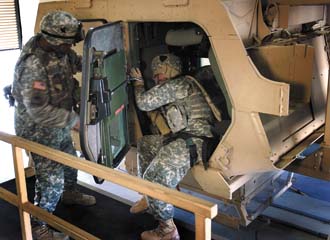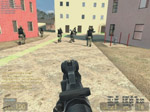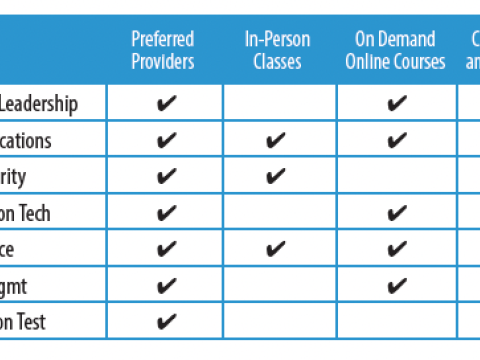Training Hits the Virtual Target
 |
One of the Army’s virtual training simulators allows warfighters to practice escaping from a Mine Resistant Ambush Protected vehicle. |
The U.S. Army is leveraging the latest advances in computing power and digital hardware to expand and improve training using virtual reality technology. Whether it is teaching soldiers how to exit an overturned vehicle safely; reinforcing lessons learned in ground patrol training; or even helping returning warriors cope with post-traumatic stress disorder, virtual reality simulations are enabling the Army to train more effectively and economically.
Virtual training simulators have been around in many forms for U.S. Air Force jet pilots for several decades. Only within the last eight years has computer technology allowed the Army to experience dramatic improvements in high-resolution display technology, digital audio and faster computer processing to create more realistic training for troops.
Currently, most development of virtual reality training, technology and programs for the Army is being directed from the Program Executive Office for Simulation, Training and Instrumentation (PEO STRI), based in Orlando, Florida. Col. Francisco A. Espaillat, USA, program manager, Combined Arms Tactical Trainers, PEO STRI, outlines the big-picture goal for the virtual training systems he helps develop.
“Our bottom line in the virtual [world] is to simulate the real-world environment the best that we can replicate it in a simulator. Our goal is to have the highest possible fidelity in our simulation capability and to immerse our soldiers in a synthetic training environment that stresses them,” the colonel explains.
Col. Espaillat notes that the ultimate objective is to provide training simulations designed to supplement and enhance live training exercises. This must take place, he says, “whether it’s our gunnery simulators that train soldiers how to fire an Abrams, Bradley or Stryker gunnery system, whether its our small marksmanship trainers on how to be better marksmen with their small arms weapons systems. All of our simulation capability,” the colonel explains, “is focused on providing our soldiers the best immersive training experience possible that would stress them, would make them practice the training that they receive at our training base.”
The colonel says virtual simulation training allows the Army to save so-called “live” training, which is more like traditional in-field training, for periods after soldiers have completed preliminary training in tactics and techniques using the simulator.
Live training enables soldiers to prepare for their mission in the area of operation they are assigned, but it is very expensive. Not only is it difficult and challenging to accomplish, but live training also is logistically intensive, requiring the movement of soldiers and all of their equipment to these training areas. The virtual realm offers a synthetic training environment that provides soldiers with the necessary tools to train on up to the level of live, Col. Espaillat says. “That’s everything they need to be stressed to train, to understand if its a gunnery system or to learn how to drive a highly complicated MRAP [Mine Resistant Ambush Protected] vehicle,” he adds.
In addition to training soldiers to drive an MRAP, Col. Espaillat says that one of the simulation programs PEO STRI has developed helps soldiers learn what to do when that MRAP has a mishap. In the simulation, trainees in full field patrol dress climb into a simulator that replicates exactly the MRAPs they will use in combat.
“MRAP vehicles are great survivability vehicles, with the v-shaped hull, 30,000-pound piece of kit. Our challenge is because of the terrain we’re currently operating in, there is a tipping point that you have to understand where it is,” the colonel explains. With a simulator, he says, soldiers can experience what happens if they hit that tipping point; and if the vehicle tips, they can practice exiting the vehicle. Then if it happens in the real world, soldiers know this is how they will react.
The colonel is especially enthusiastic about another training simulation system now under development called Dismounted Soldier, which he says will, for the first time, extend the capabilities of virtual simulation training to ground troops at the squad level.
“We’re building a squad-level trainer, a nine-person trainer, that immerses a soldier in a training environment, and has them go through different scenarios as to where they would be in the area of operations.”
Col. Espaillat borrows an analogy from the popular science-fiction television program and movie “Star Trek,” which features a fictional, futuristic room—called a holodeck—that provides a virtual environment containing realistic three-dimensional simulations and projections of people and objects. Col. Espaillat explains that, “What I’d like you to envision is a ‘Star Trek’ holodeck. We’re getting ready to start in pursuit of a ‘Star Trek’ holodeck-like capability. Very exciting, because every soldier, every service member at some point, has to get out of that vehicle, whether it’s an airplane, whether it’s a tank, or it’s a truck. They have to get out of that vehicle, and they have to understand how to train.”
 |
The Dismounted Soldier system, now under development, will for the first time extend virtual simulation training to ground troops at the squad level. It allows warfighters to practice a variety of situations they might encounter in the field. |
In addition to determining the hardware, some technical hurdles still exist. Among them is the problem of how to simulate a group of soldiers moving across the ground in a shared virtual squad training scenario under Dismounted Soldier.
The challenge exists in creating the motion of the individuals in the synthetic environment. The simulation must replicate soldiers moving around when they actually are not, yet they feel as if they are, and they feel as if they are together.
To address this requirement, the Army is using another computer-based technology gaming system to help train current warfighters.
Leslie Dubow is the project director for the Army’s Games for Training, also based at PEO STRI. Her office is helping to oversee a program that uses existing computer games and adapts them to the “serious fun” of training our troops.
Dubow believes that, “[The Army] must ‘roll with the way people want to learn,’ and leverage the current philosophy that ‘I can’t live without my iPhone,’” in trying to design computer-based training that meets those expectations.
Dubow relates that prior to 2007, the Defense Advanced Research Projects Agency (DARPA) had been trying to develop its own convoy training application to leverage games for training in a “niche in which we could not train before—a small unit in a networked environment.”
At one point, however, she says that “the light switch went on,” and developers realized that instead of creating applications from scratch and programming them to be dependent on custom software, they simply could program existing game engines. These systems, already enjoyed by gaming enthusiasts, could become virtual trainers for soldiers.
Dubow also says that the Army struggled with the semantics of what to call the use of video games for training. “The term ‘Immersive Training Systems’ was considered,” she says, until an officer realized that they were trying to adapt gaming technologies, so they found the more descriptive title of “Games for Training.”
She says the U.S. Marine Corps was the first among the U.S. military services to use the initial iteration of the game, now known as “Virtual Battlespace 1.” The Army acquired an enterprisewide license for the game in 2008.
The current version, Virtual Battlespace 2 (VBS2), was developed by Bohemia Interactive, in conjunction with the Army’s Games for Training program, the U.S. Marine Corps, as well as overseas military customers including the Australian Defence Force, Canada, NATO and others. Dubow explains that the game is an executable thin-client, designed to be downloaded to individual battle commands’ training centers and deployed for use on those centers’ local area networks. She says the application has been optimized to run on Windows Vista 64-bit, and will work with the newest version of the Windows operating system, Windows 7. So far, it has been sent to 75 battle command training centers.
Even as soldiers are using VBS2, Dubow says efforts to improve the battle training scenario continue. In late March, the Army held the second annual Army Games for Training User Conference in Orlando, designed as an opportunity for VBS2 users to exchange notes on innovations. Most notable of the new features is the ability to create simulated battle environments based on real-world locations and scenarios for training.
Dubow notes that during the meeting, U.S. Secret Service representatives announced that they already have used the runtime editor for VBS2 to create virtual replicas of locations around the Washington, D.C., area in which they operate for training their agents. She says that training managers in the field have been clamoring for more scenarios based on actual field operations sites in Afghanistan. In response, a note recently was placed in the MilGaming forum, where more than 15,000 U.S. military members and contractors using VBS2 have created what she describes as a repository for a mix of social media and applications.
Within a week, members had shared a 25x25-kilometer simulated terrain based on tactical missions conducted in Afghanistan.
Dubow says various games are training troops in other areas. The game Moral Combat, developed by the Army Center of Excellence for the Professional Military Ethic, is being used to train troops to conduct themselves in an ethical manner during combat operations. An application named Bilateral Negotiations, based on the book Getting to Yes by Roger Fisher and William Ury, is designed to help troops and officers obtain local infrastructure support from residents and, as Dubow says, “winning hearts and minds.” DARPA currently is developing a tactical language and culture training application, and a push is underway to develop an iPad version of VBS2.
One challenge to acquiring these applications, based on rapidly changing software and hardware, is development and acquisition time. It took eight months for the Software Engineering Directorate, U.S. Army Aviation and Missile Research Development and Engineering Center, a subordinate laboratory to the Research, Development and Engineering Command, located at Redstone Army Arsenal, Huntsville, Alabama, to develop VBS2, but it took more than a year to do the paperwork, including testing and contracting.
Army officials have mandated that ways be found to expedite both development and contracting, but Dubow acknowledges that the PEO STRI staff is facing an uphill battle in this regard.
In the area of military medicine, virtual technologies also are being used to help returning service members cope with the stresses they encountered on the battlefield. The National Center for Telehealth and Technology (T2), part of the Defense Centers of Excellence for Psychological Health and Traumatic Brain Injury, unveiled its Virtual Post-Traumatic Stress Disorder (PTSD) Experience in January. This program is designed to give returning combat veterans a place to learn about the causes and symptoms of PTSD and to offer resources for information and treatment. Dr. Kevin Holloway, research psychologist and program manager with T2, says the website features a Second Life-based scenario designed to draw in potential clients in need of treatment for PTSD.
“We really want to go beyond the typical 2-D [two-dimensional] website with text and videos,” he relates, “and try to provide an immersive, interactive learn-by-doing experience.” He believes this would be a good fit with the virtual worlds space.
Holloway says the Second Life PTSD site is the result of almost three and a half years of work, and it builds on other research into ways to better provide information on PTSD to service members.
WEB RESOURCES
PEO STRI: www.peostri.army.mil/
T2 Virtual PTSD: www.t2health.org/vwproj
Virtual Training Is a Growth Area An August 2010 report from the London-based industrial analysis firm Visiongain estimates that the global market for military simulation and virtual training had reached $8.4 billion by the end of last year. Visiongain officials say that growth is driven in part by the need for many governments to reduce overall training costs and by exponential improvements in computing power. Dr. Paulette Robinson, assistant dean for teaching, learning and technology at the National Defense University (NDU), Washington, D.C., and one of the leaders in the development of digital simulation technology in the government, says that the mandate for a framework for the use of virtual technologies for training comes from the highest ranks of the Defense Department, in the Office of the Secretary of Defense. Robinson notes that, along with the Army, the Air Force has developed a Second Life island using that Web platform for training purposes. At Fort Sam Houston in Texas, the Defense Department has replicated the entire base in a virtual world to facilitate medical training activities. “They’re using it for onboarding but also for medical simulations that are going to connect to this virtual world,” she relates. Robinson, who also heads the yearly “Federal Consortium for Virtual Worlds” conference, held at the NDU, says 3-D simulation, such as the kind now under development at PEO STRI in Orlando, offers another avenue for growth in the use of simulation for training. The Federal Consortium for Virtual Worlds conference showcases both software applications and developments in interactive hardware that one day could find their way into the training programs now under development by PEO STRI. |




Comments